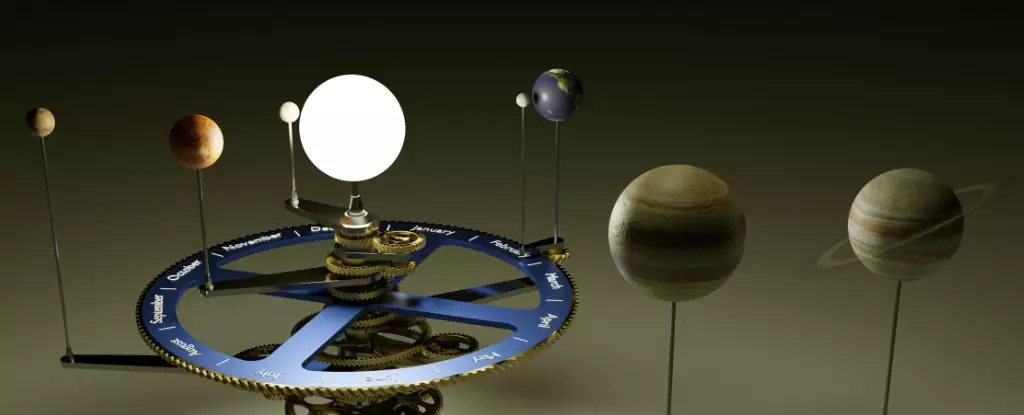As the twilight hour approaches in the months of February and March, skywatchers are treated to a rare cosmic spectacle—an alignment of nearly all the naked-eye planets in the Solar System. This occurrence, which involves the swift inner planet Mercury finally joining the mix, is a reminder of the celestial wonders that are often hidden from our view. As we delve deeper into the skies, we’ll explore the significance of this alignment, how to observe these celestial bodies, and what astronomical events to anticipate in the coming weeks.
Throughout history, planetary alignments have captivated the imagination, giving rise to both myths and legends. The current alignment offers a unique opportunity for amateur astronomers and casual stargazers alike. January may have showcased most of the naked-eye planets, but the absence of Mercury was felt keenly. As February unfolds, Mercury finds its place in the sunset lineup, allowing observers the chance to see a full cast of characters marching across the evening sky.
Mercury, known for its rapid orbital speed, often eludes detection due to its proximity to the Sun. However, after completing a solar conjunction on February 9, it now re-emerges low on the western horizon. For those attempting to add Mercury to their astronomical repertoire, a strategic observer can utilize Venus as a guiding light. As the brightest planet, Venus serves as an invaluable reference point for spotting the elusive Mercury just 1.5 degrees north of Saturn on February 25.
A Window of Opportunities
An essential component of appreciating the night sky is knowing when and where to look. Observers can take advantage of these celestial events by planning their stargazing outings. Starting with Mercury, the best chance to catch this planet will occur at dusk, where it dances alongside Saturn and the waxing crescent Moon.
The crescent Moon will join Mercury on March 1st, providing an extraordinary opportunity for observation. This event, termed an occultation for specific regions such as Hawaii and the Pacific islands, illustrates how planetary movements can create striking visual phenomena in our sky. The upcoming sporting events among the planets peak as Mercury reaches its maximum separation from the Sun on March 8, at an impressive 18 degrees. Aspiring astronomers should aim their telescopes to witness this fleeting moment, as it will grant a view of Mercury’s illuminated half-disk.
While Mercury and Venus race toward conjunction, Mars, standing firmly in the constellation Gemini, offers another treat. With brightness peaking at a striking -0.58 magnitude, ruddy Mars is hard to miss—especially after its opposition on January 16. Astronomical events tied to Mars unfold throughout March, culminating in a Moon encounter on March 9. The interplay of these celestial bodies offers a dynamic and engaging tableau for observers armed with binoculars or telescopes.
Shifting our gaze further back in the Solar System, we find Jupiter reigning high in the southern skyline. The gas giant, known for its stunning beauty and dynamic weather patterns, promises to be a key player throughout the transition from February to March. Its peak visibility coincides with the waxing crescent Moon on March 6, and interestingly enough, this also marks a critical moment in astronomical history—Ole Rømer’s discovery that the speed of light varies, capturing the intrigue of scientific inquiry. Jupiter serves as a cornerstone for many observing enthusiasts, standing tall and magnificent.
The adventure does not end with the visible planets. Saturn also makes an appearance, albeit positioned lower and more challenging to locate beneath the Martian glow. Once you’ve successfully navigated your way to Mercury, binoculars will assist in spotting the faint rings of Saturn, though they may be viewed edge-on on March 23. In addition, observers should not overlook the outer ice giants, Uranus and Neptune. While Uranus may be relatively accessible in Taurus, Neptune, at a magnitude of +7.8, presents a more formidable challenge for those looking to capture the distant world with their telescopes.
As we anticipate the celestial events which will transition us into the spring season, it’s worth noting the two upcoming eclipses: a partial solar eclipse on March 29 and a total lunar eclipse on April 14. As we set our sights on these cosmic events, preparation is key. Engaging with the natural world around us will foster a sense of connectedness and wonder, enhancing the experience of witnessing these majestic celestial performances.
As twilight settles upon the Earth, the planets engage in a cosmic dance, enriching our nights and whispering tales of the vast universe that lies beyond our own. The coming weeks offer a rich tapestry of opportunities for stargazers—both seasoned and novice. As the planets align and string together a glorious show, take some time to step outside, look up, and partake in the celestial wonder. In pursuit of our planetary quest, it is the shared connection with the cosmos that ultimately binds us together.


Leave a Reply